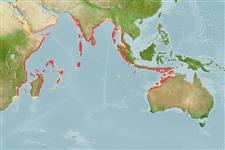Common names from other countries
>
Eupercaria/misc (Various families in series Eupercaria) >
Caesionidae (Fusiliers) > Caesioninae
Etymology: Caesio: Latin, caesius, bluish-grey, 1835; it is the same name given to the silvery metal (Cs) (Ref. 45335).
More on author: Bleeker.
Environment: milieu / climate zone / depth range / distribution range
Ecologia
marinhas associadas(os) a recifes; não migratória; intervalo de profundidade 0 - 50 m (Ref. 402). Tropical; 23°N - 28°S, 32°E - 132°E (Ref. 94071)
Indian Ocean: East Africa (not including the Red Sea and the Arabian (Persian) Gulf) to Indonesia. Records of this species from the Marshall Islands and Australia are probably misidentifications of Caesio teres.
Tamanho / Peso / Idade
Maturity: Lm ? range ? - ? cm
Max length : 40.0 cm TL macho/indeterminado; (Ref. 402)
Espinhos dorsais (total) : 10; Raios dorsais moles (total) : 14 - 15; Espinhos anais: 3; Raios anais moles: 11 - 12. Upper 1/3 of body and caudal fin bright yellow, middle third blue, lower white. 4-5 scales on cheek; 20-25 predorsal scales; scaled dorsal and anal fins; narrow scaleless zone interrupting the Supra-temporal band of scales at the dorsal midline. Upper peduncular scale rows 11 or 12; lower peduncular scale rows usually 15 (14-16). Presence of a small process on each ventrolateral surface of basioccipital for attachment of Baudelot's ligament. Post maxillary process single; posterior end of maxilla blunt (Ref. 1723). Head length 3.0-3.4 in SL; body depth 2.9-3.5 in SL (Ref. 90102).
Inhabits deep lagoons and along seaward reefs (Ref. 9710), primarily around coral reefs. Feeds on zooplankton in large midwater aggregations. Oviparous, with numerous, small pelagic eggs (Ref. 402).
Life cycle and mating behavior
Maturities | Reprodução | Spawnings | Egg(s) | Fecundities | Larvas
Carpenter, K.E., 1987. Revision of the Indo-Pacific fish family Caesionidae (Lutjanoidea), with descriptions of five new species. Indo-Pac. Fish. (15):56 p. (Ref. 1723)
Categoria na Lista Vermelha da IUCN (Ref. 130435)
CITES (Ref. 128078)
Not Evaluated
Ameaça para o homem
Harmless
Utilização humana
Pescarias: pouco comercial
Ferramentas
Relatórios especiais
Descarregue XML
Fontes da internet
Estimates based on models
Preferred temperature (Ref.
115969): 26 - 29.3, mean 28 (based on 312 cells).
Phylogenetic diversity index (Ref.
82804): PD
50 = 0.5020 [Uniqueness, from 0.5 = low to 2.0 = high].
Bayesian length-weight: a=0.01259 (0.00551 - 0.02875), b=3.09 (2.90 - 3.28), in cm Total Length, based on LWR estimates for this (Sub)family-body shape (Ref.
93245).
Nível Trófico (Ref.
69278): 3.4 ±0.45 se; based on food items.
Resiliência (Ref.
120179): Elevada, tempo mínimo de duplicação da população menor que 15 meses (Preliminary K or Fecundity.).
Fishing Vulnerability (Ref.
59153): Low to moderate vulnerability (30 of 100).
